The Senate is an institution steeped in tradition. While some traditions prove to be long lasting, others come and go. Such is the case with one tradition of gift giving in the Senate around the Christmas holiday.
Christmas was not always an eventful holiday in the Senate. Prior to the 1850s, senators took very little time off while the Senate was in session. The legislative session started in the first week of December and, in the era before widely available railroad service, it was too onerous to travel home for a short holiday break. The Senate was typically in session on December 24, adjourned for Christmas Day, then returned to business on December 26. Not until 1857 did senators resolve to take a recess for the Christmas and New Year holidays. In 1870 Congress passed legislation that made Christmas a holiday for federal employees in the District of Columbia. By the 1890s newspapers reported that attendance in both houses of Congress was “steadily diminishing” as the holiday approached, noting the Capitol was “practically deserted.”1
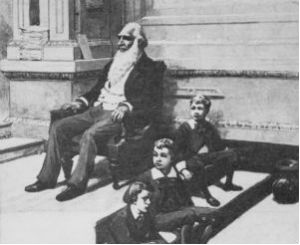
The absence of senators during a holiday recess meant there was time for those who stayed in town, especially staff, to celebrate the season. Soon, gift giving became part of the Senate’s holiday tradition. On Christmas Day 1862, for example, the Chamber’s messengers presented their supervisor Isaac Bassett—the assistant doorkeeper who began his 64-year Senate career as a page in 1831—with an engraved gold-topped cane to thank him for his service, in particular for “always showing the utmost courtesy to the messengers under his direction.”2
Another notable gift came in 1902, when Senate Sergeant at Arms Daniel M. Ransdell received a package from an unknown sender. Ransdell carefully removed the gold-foil wrapping from the package to find 14 ounces of anthracite coal. Before assuming that he was on the “naughty list,” know that the lump of coal was actually a welcome gift. Ransdell had been short on fuel for heating the Capitol that season.3
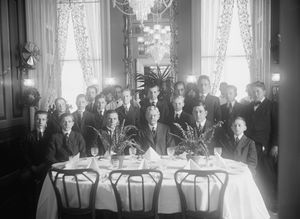
In the late 19th century, holiday celebrations—which had long been public displays of revelry—became more focused on children. In the Senate, gift-giving traditions centered on the youngsters employed as Senate pages.
In 1887 California senator Leland Stanford, a multimillionaire, gave each page a five-dollar gold coin at Christmas. Isaac Bassett was charged with dispensing the gift and, though not a rotund man, his white hair and long beard and his “merry eye and cheerful voice” led the pages to dub him Santa Claus.4
Vice President Thomas R. Marshall began a tradition in 1913 of an annual Christmas dinner with the pages in the Senate dining room. Pages were treated to a sumptuous holiday spread and toasted for their hard work. Marshall then offered sage advice to the sated boys on how to succeed after they left the Senate’s employ. Calvin Coolidge continued the tradition when he became vice president in 1921.5
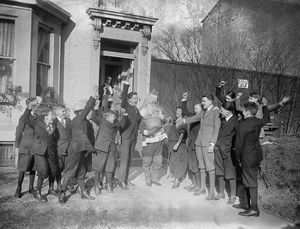
Some senators took advantage of the annual dinner to give the pages tokens of their appreciation. In 1915 Senator George Oliver of Pennsylvania and Senator James Martine of New Jersey gave each page a crisp new dollar bill. The following year Senator Willard Saulsbury of Delaware joined Oliver in giving cash gifts to the 16 pages. For a number of years Senator John Kendrick of Wyoming gave each page a new necktie. In an oral history interview conducted decades later, page Donald Detwiler recalled a Christmas dinner in 1917 at which Senator James D. Phelan of New York presented each page with a book.6
When the vice presidency was vacant in 1923—Coolidge had ascended to the presidency after the death of Warren G. Harding—a newspaper reporter quipped that “tiny Tim,” the smallest of the Senate pages, had lost his Santa Claus because no substitute had emerged to carry on the holiday tradition.7
The pages needn’t have worried. A few days after Christmas, Maud Younger, congressional chairwoman of the National Woman’s Party, learned that the pages might miss their celebration and invited them to her home for a feast. Arkansas senator Thaddeus Caraway donned a Santa Claus suit and arrived at Younger’s home with a bag of gifts. In 1925 Senator Robert Stanfield of Oregon took over the role of Santa and distributed gifts to the pages on the steps of the Capitol.8
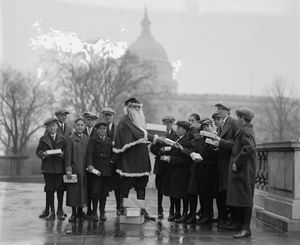
When Vice President Charles Dawes revived the Christmas page dinner in 1925, the appreciative pages decided to turn the tables and offer their own gifts to the vice president. They delivered gifts to Dawes in a giant paper-mache pipe, a nod to his affinity for smoking a Lyon pipe (he became so identified with it that it became known after as the Dawes pipe). The gifts included a copy of the Senate rules “shot full of holes,” a clever reference to Dawes’s much-publicized harangue against Senate procedures that he had delivered from the presiding officer’s chair earlier that year. At the 1927 dinner, the pages presented Dawes with a new set of rules they had written to give the vice president complete control over Senate debate. Another gift was a model of a yellow taxicab, to mark the day that Dawes slept peacefully at the Willard Hotel when he was needed to cast a critical tie-breaking vote. Dawes had been awakened and hopped into a cab to rush back to the Chamber only to find he was too late to cast a vote. A few years later, the pages presented Vice President Charles Curtis with a tool to maintain order in the Chamber: a giant paper-mache gavel. The pages informed Curtis that should a senator become disorderly, the gavel was “guaranteed to mash ’em flat.” In return, Curtis gave each page a silver dollar.9
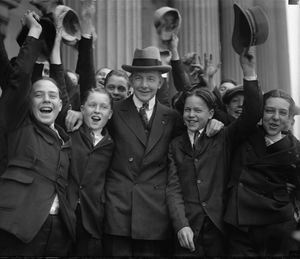
The vice president’s annual Senate page Christmas dinner and the associated gift giving continued a few more years, but the nascent tradition came to an end in the 1930s. Part of the reason for its demise was the adoption in 1933 of the 20th Amendment to the Constitution, which moved the start of congressional sessions from December to January. With the Senate recessing by fall in the years that followed, neither the vice president nor the pages were on duty at the Capitol for the holiday season. By the 1960s, when Senate sessions were growing longer and often extending into December, both the page program and the vice presidency had undergone changes. Rather than employing local youngsters for multiple years, the page program began accepting high school students from around the country to serve one semester at a time. By this time, the vice president also spent less time at the Capitol. Assuming more executive duties, the vice president began presiding only on ceremonial occasions or when needed to break a tie vote. Once a cherished Senate tradition, the annual gift exchanges disappeared and became lost to the past.
Notes
1. Congressional Globe, 35th Cong., 1st sess., December 23, 1857, 156; Jacob R. Straus, "Federal Holidays: Evolution and Current Practices," Congressional Research Service, R41990, updated July 1, 2021; “Holiday Pressure Is Growing,” Washington Post, December 19, 1892, 6; “Around the Capitol,” Baltimore Sun, December 25, 1894, 2.
2. Isaac Bassett Papers, Box 20, Folder G, p. 180, Records of the U.S. Senate, Record Group 46, National Archives and Records Administration, Washington, D.C. [online version available through Archives Research Catalog (ARC Identifier 5423124, p. 22) at https://catalog.archives.gov/id/5423124].
6. “Senators Remember Pages and Officials,” Washington Times, December 25, 1915, 6, Chronicling America: Historic American Newspapers, Library of Congress, accessed December 1, 2020, https://chroniclingamerica.loc.gov/lccn/sn84026749/1915-12-25/ed-1/seq-6/; “Senate Pages Receive Gifts,” Washington Evening Star, December 23, 1916, 10, Chronicling America, https://chroniclingamerica.loc.gov/lccn/sn83045462/1916-12-23/ed-1/seq-10/; Washington Evening Star, January 4, 1925, Chronicling America, https://chroniclingamerica.loc.gov/lccn/sn83045462/1925-01-04/ed-1/seq-85/; “Senate Chief Pages Get Christmas Gifts,” Washington Herald, December 25, 1915, 9, Chronicling America: https://chroniclingamerica.loc.gov/lccn/sn83045433/1915-12-25/ed-1/seq-9/; "Donald J. Detwiler: Senate Page (1917–1918),” Oral History Interview, August 8, 1985, Senate Historical Office, Washington, D.C., available at https://www.senate.gov/about/oral-history/detwiler-donald-oral-history.htm.
9. “Curtis Gets a Huge Gavel,” New York Times, December 25, 1930; “'Study Senators' Is Advice to Pages,” Washington Evening Star, December 25, 1929, 4, Chronicling America, https://chroniclingamerica.loc.gov/lccn/sn83045462/1929-12-25/ed-1/seq-4/ ; “Dawes Gives Christmas Party,” Washington Post, December 24, 1926, 4; “New Set of Rules Is Dawes’s Gift from Pages in Senate,” Hartford Courant, December 23, 1927, 10; “Senate Pages Turn the Tables on Dawes,” New York Times, December 24, 1926, 2.